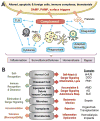Complement in immune and inflammatory disorders: pathophysiological mechanisms
- PMID: 23564577
- PMCID: PMC3623009
- DOI: 10.4049/jimmunol.1203487
Complement in immune and inflammatory disorders: pathophysiological mechanisms
Abstract
Although acute or chronic inflammation is a common component of many clinical disorders, the underlying processes can be highly distinct. In recent years, the complement system has been associated with a growing number of immunological and inflammatory conditions that include degenerative diseases, cancer, and transplant rejection. It becomes evident that excessive activation or insufficient control of complement activation on host cells can cause an immune imbalance that may fuel a vicious cycle between complement, inflammatory cells, and tissue damage that exacerbates clinical complications. Although the exact involvement of complement needs to be carefully investigated for each disease, therapeutic modulation of complement activity emerges as an attractive target for upstream inhibition of inflammatory processes. This review provides an update about the functional and collaborative capabilities of complement, highlights major disease areas with known complement contribution, and indicates the potential for complement as a focal point in immunomodulatory strategies for treating inflammatory diseases.
Figures


References
Publication types
MeSH terms
Substances
Grants and funding
- AI003040/AI/NIAID NIH HHS/United States
- DE021685/DE/NIDCR NIH HHS/United States
- AI072106/AI/NIAID NIH HHS/United States
- GM097747/GM/NIGMS NIH HHS/United States
- R01 AI030040/AI/NIAID NIH HHS/United States
- R01 GM097747/GM/NIGMS NIH HHS/United States
- EY020633/EY/NEI NIH HHS/United States
- R01 DE021685/DE/NIDCR NIH HHS/United States
- R01 EY020633/EY/NEI NIH HHS/United States
- AI097805/AI/NIAID NIH HHS/United States
- AI068730/AI/NIAID NIH HHS/United States
- R21 AI097805/AI/NIAID NIH HHS/United States
- P01 AI068730/AI/NIAID NIH HHS/United States
- R01 AI072106/AI/NIAID NIH HHS/United States
LinkOut - more resources
Full Text Sources
Other Literature Sources
Medical

